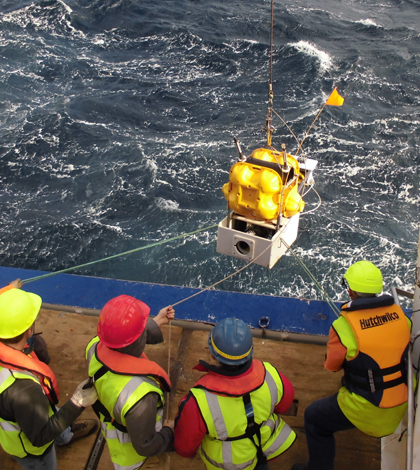Slow Underwater Earthquakes Similar To Those Causing Tsunamis

Seafloor absolute pressure gauges lashed to the deck of the R/V Roger Revelle. The devices monitor slow-slip events on the ocean floor. (Credit: Justin Ball / University of Colorado)
Some of the world’s most devastating tsunamis are caused by earthquakes that take place far under the surface of the oceans. These occur near the trenches of subduction zones, places where one tectonic plate begins to dive or “subduct” beneath another.
When that subduction takes place, large quantities of ocean water are disturbed, dropped enough in height that a wave is created. Once it gathers speed and strength, a powerful tsunami can form. Not surprisingly, scientists would like to know more about the nature of these deep-sea earthquakes and researchers at the University of Texas have recently led an effort to dissect them.
In a work off the coast of New Zealand, they and a group of international scientists deployed 24 seafloor pressure gauges and 15 ocean bottom seismometers in May 2014. These were left in the region for over a year, and then retrieved in June 2015. The study took place at the Hikurangi subduction zone, where the Pacific Plate subducts beneath New Zealand’s North Island.
Throughout the period, the instruments gathered information on a slow-slip event, or slow-motion earthquake, that occurred there. It’s the first time that the true extent of slow-motion earthquakes at an offshore subduction zone has been recorded.
The event the team studied occurred in the same location as a magnitude 7.2 earthquake in 1947 that generated a large tsunami. The slow-slip event lasted two weeks, resulting in 15-20 centimeters (about 6-8 inches) of movement along the fault that lies between New Zealand and the Pacific Plate, a distance equivalent to three to four years of background plate motion.
If the movement had occurred suddenly, rather than slowly, it would have resulted in a magnitude 6.8 earthquake. The seafloor sensors recorded up to 5.5 centimeters (about 2 inches) of upward movement of the seafloor during the event.

Scientists deploy an ocean bottom seismometer and absolute pressure gauge offshore Gisborne, New Zealand from the R/V Tangaroa. (Credit: Takeo Yagi / University of Tokyo)
The data show how slow earthquakes can rupture the shallow portion of a fault that is also known to move during large earthquakes that generate tsunamis. The finding increases the understanding of the relationship between slow-slip and normal earthquakes by showing that the two types of seismic events can occur on the same part of a plate boundary.
The link has been difficult to document in the past because most slow-slip monitoring networks are land-based and are located far from the trenches that host tsunami-generating earthquakes. But this study got around that with the sensors it deployed, named as a whole the HOBITSS network, for “Hikurangi Ocean Bottom Investigation of Tremor and Slow Slip.”
Researchers say that their results show that shallow, slow-slip event source areas are also capable of hosting seismic rupture and generating tsunamis. Because of that, they suggest more monitoring is needed for shallow, offshore slow-slip events at subduction zones, perhaps using permanent monitoring networks.
Earthquakes are unpredictable events, but the linkage between slow-slip events and earthquakes could eventually help in forecasting the likelihood of damaging earthquakes strong enough to generate tsunamis.
An international team of researchers from the U.S., Japan and New Zealand collaborated on the research. It was funded by the National Science Foundation; the Japan Society for Promotion of Science; Japan’s Ministry of Education, Culture, Sports, Science and Technology; and grants from participating universities and research institutions.
Top image: Seafloor absolute pressure gauges lashed to the deck of the R/V Roger Revelle. The devices monitor slow-slip events on the ocean floor. (Credit: Justin Ball / University of Colorado)





0 comments